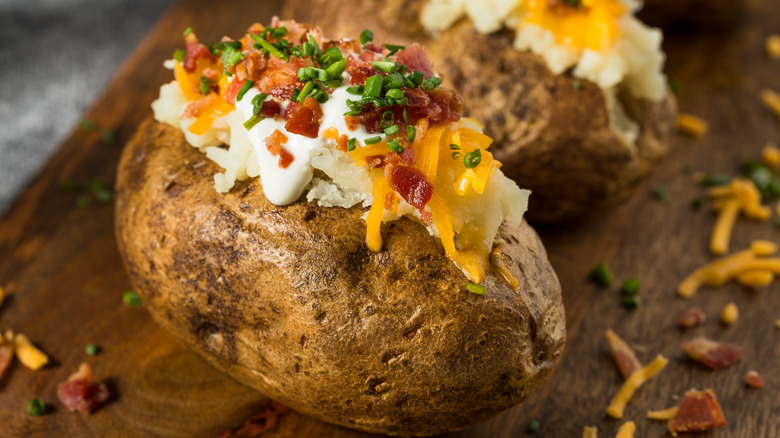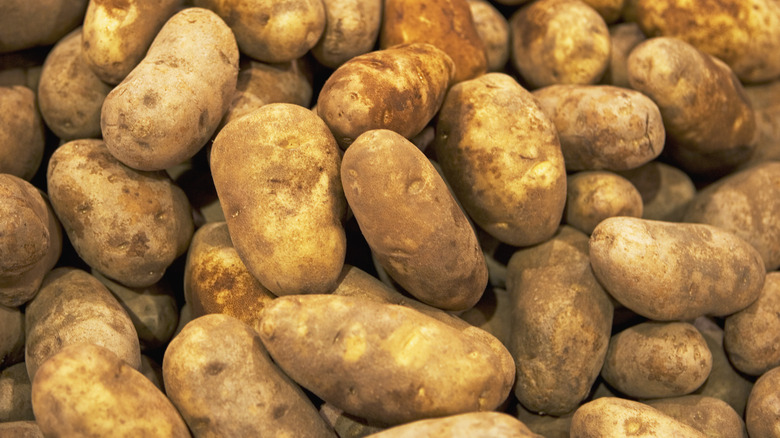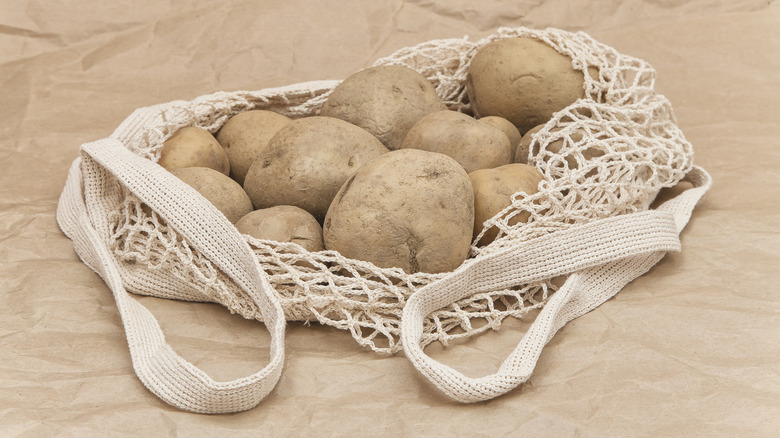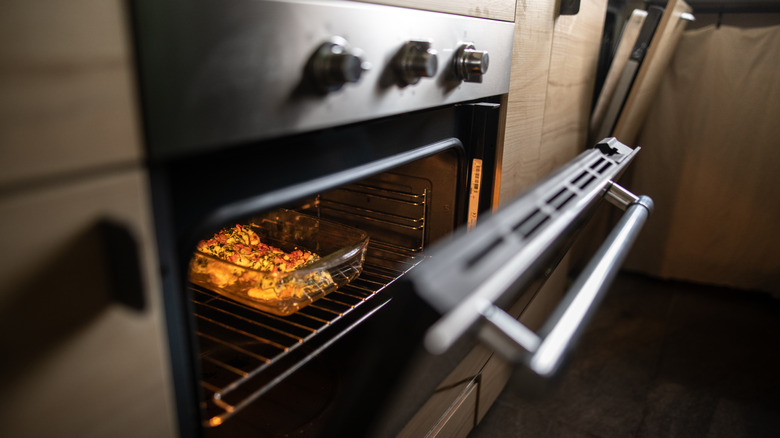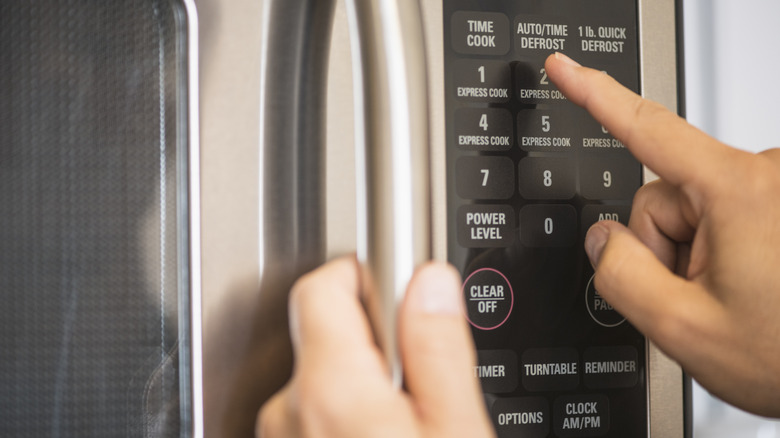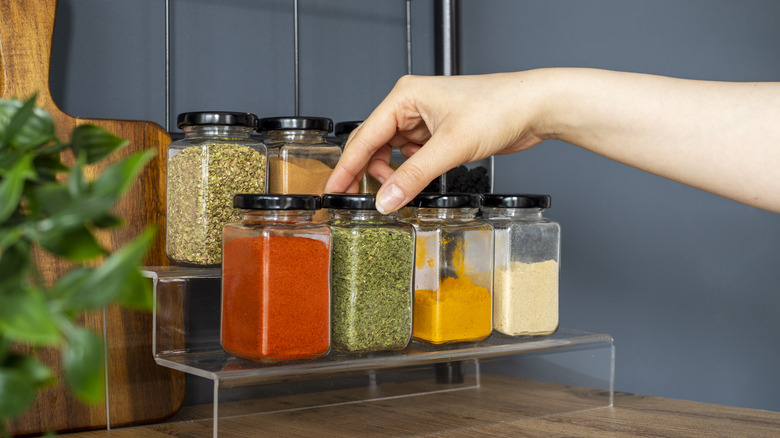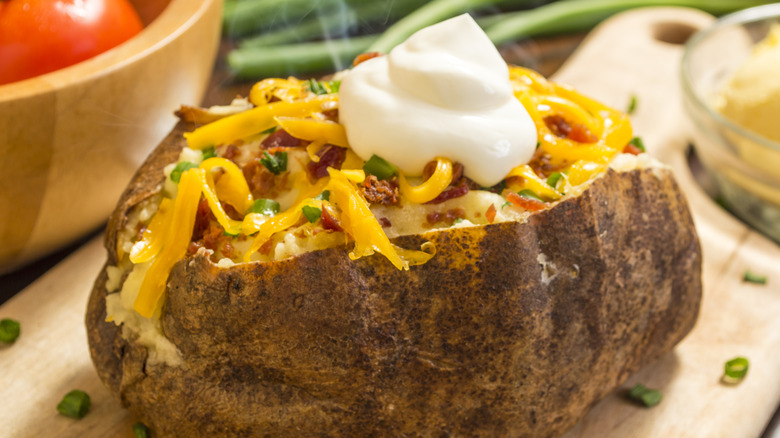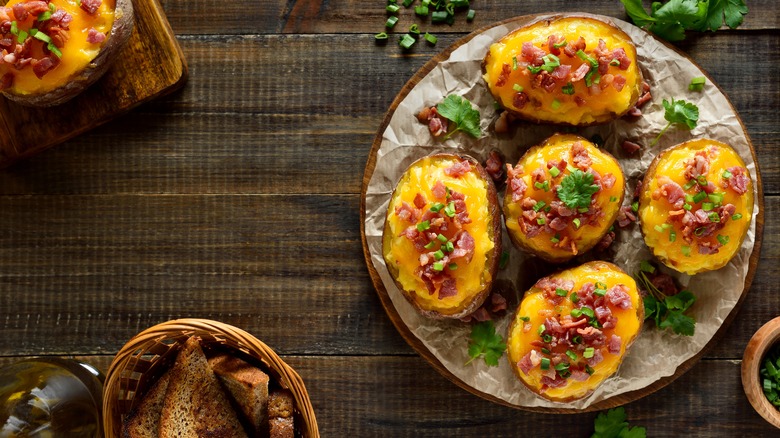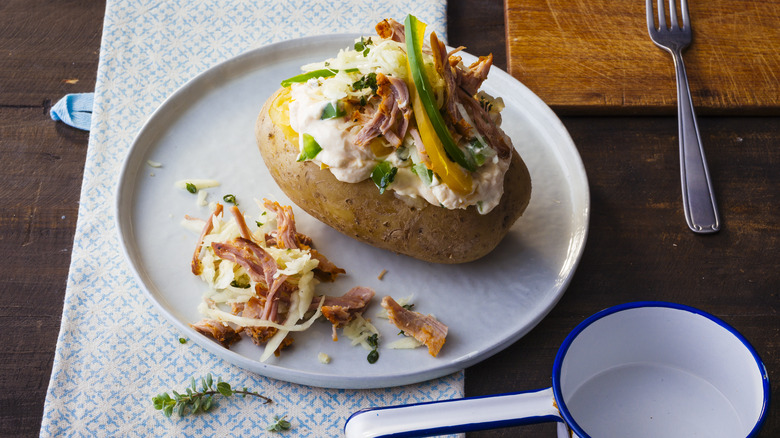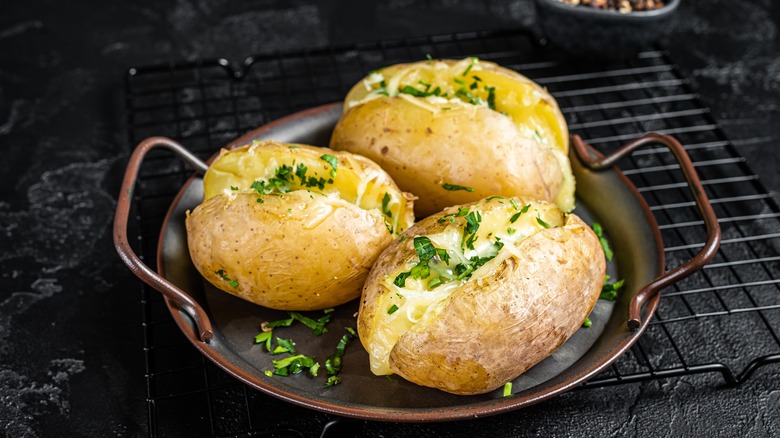Why Restaurant Baked Potatoes Always Taste Better Than Homemade
Baked potatoes are a classic, homey, comforting side dish that almost always tastes better at restaurants. Baked potatoes can even sometimes be meals all on their own, with the right toppings and additions. It can be disappointing to prepare a baked potato at home, only for it to come out tasting dry, stale, and nothing like the fluffy, flavorful potato you would order at a restaurant.
But what really causes this discrepancy that makes restaurant baked potatoes taste better than homemade? The reality is, there are a myriad of advantages that professional chefs have at restaurants that you just may not have at home. From knowing the type of potato you should choose to having the right cooking equipment to choosing the right toppings, making baked potatoes at home can be more of an intricate process than just popping a potato in the microwave for a few minutes.
Thankfully, we spoke to a few industry professionals who gave us insight into what exactly gives restaurants the edge up when it comes to tasty baked potatoes. If you know what the restaurants are doing differently, you might have a better chance at recreating a restaurant-style baked potato at home, according to these experts we spoke to on the matter: Stephanie Edenburgh, CEO of Bizzie Mommy, Rena Awada, owner and head chef of Healthy Fitness Meals, Corrie Duffy of Corrie Cooks, Ranveer Brar of Kashkan Restaurants, Jessica Randhawa, owner and head chef of The Forked Spoon, Dan Gallagher, a registered dietitian at Aegle Nutrition, and Matt Rogers, a certified nutritionist at Tropical Oasis.
Quality and type of potato
This first one may seem like the simplest, but choosing the wrong type of potato, or a poor quality potato, is one of the biggest mistakes home cooks can make. Stephanie Edenburgh has noticed that many restaurants use russet potatoes because of their thick skin and starchy interior. "When I've tried different varieties at home, I've found that russets really do give you that fluffy, light texture inside and crisp skin outside that makes restaurant potatoes so satisfying," Edenburgh said.
Russet potatoes are usually more elongated than other types of potatoes, which makes them perfect for the classic baked potato shape. Plus, russets are more mild in the flavor department, so they easily soak up the flavors of whatever ingredients and toppings you choose to use for your baked potato. With russets, you can easily customize your potato to taste exactly how you want it to, whereas Yukon Golds, as compared to russets, are creamy, buttery, and nutty in flavor, so they are less of a "blank canvas" than russet potatoes.
Quality is a big aspect of a good baked potato, as well — it may be better to shop for your potatoes individually rather than in a bag, as you can better inspect each potato you choose to see if it has spuds, bruises, or any dents. Choosing a smooth russet potato is the first step in making the best restaurant-style baked potato you have ever attempted.
Method for storing the potatoes
It is easy to get home from the grocery store and just toss your bagged potatoes on any part of your counter — but this is not the best way to keep your potatoes fresh and spudless. Like all other vegetables, the temperature at which potatoes are stored can greatly impact how long they go without spoiling. Ideally, potatoes are stored within 43 F to 50 F, which could keep them fresh and usable for a few months.
This temperature is a middle ground between refrigeration — which is too cold for potatoes — and pantry storage — which can be too warm. Slightly colder than room temperature is the best way to store potatoes; rooms and shelving that meets these requirements are usually basements, garages, or cellars.
It also matters the container that you store potatoes in. Some home cooks have found that potatoes are best stored in cardboard boxes, because the russets they stored in this manner remained smooth — without sprouts — perfect for a baked potato. If you do not have a cardboard box, though, you can try storing potatoes in a paper bag, which also lead to spudless russet potatoes that were moist and still firm.
Cooking technique and equipment
It is clear that professional chefs at restaurants have access to some of the most top-notch cooking equipment, which gives them an edge up at creating the best baked potatoes. But what about this equipment is actually special, and can you replicate it at home? According to Rena Awada, restaurant ovens can reach higher temperatures than a typical home oven, and — more importantly — the restaurant ovens distribute the heat evenly for a better baked potato result.
"Home cooks can try to replicate this by preheating their oven to a high temperature and using an oven thermometer to ensure even heat distribution," Awada said. Oven thermometers are one of the most essential kitchen tools, since many oven knob (temperature) readings might be different than the actual temp inside. This could negatively affect your baked potatoes — and anything else you choose to cook. The ideal temperature for baking a potato, according to Stephanie Edenburgh, is around 400 F to 425 F.
The technique you use to cook your baked potato is important, too. Corrie Duffy recommends baking the potatoes directly on the oven rack initially, so you get a crispier skin. If this does not seem ideal to you, you can try preheating a baking sheet and baking the potatoes on that, so they have direct contact with the heat right from the start of the bake.
Restaurants don't cut corners
Baked potatoes are always delicious, but they are not often the quickest dinner side dish to make. In fact, many online recipes call for anywhere from 45 minutes to 60 minutes to prep and bake a baked potato, and on an average weeknight, many people do not have the ability to spend that much time on dinner. Unfortunately, the solution is often to pop your potatoes in the microwave for a few minutes, or even as long as the "potato" button on the microwave allots for. But this is not the best idea.
If you are microwaving your baked potatoes, this is the reason why you are not making restaurant-worthy baked potatoes. When a potato is microwaved, it is cooked in a rather chaotic method, being zapped as it spins in circles, causing one part of it to get warm and soft, and another to stay rock solid. This leads to potatoes that become gummy with wrinkles, rather than the velvety creaminess with a crisp exterior that you would get in the oven.
It may take longer to thoroughly cook a baked potato in the oven, but to get a restaurant-style baked potato, this is the way to do it. Professional chefs do not take shortcuts, and as a result, their food turns out the best — if you use your oven, your baked potatoes can, too.
Ingredients and seasoning
Your dish is only ever as good as the ingredients you use, and most restaurants are sure to have some of the highest-quality ingredients on the market — and they are not afraid to use them. Restaurants are often generous with the use of butter, sour cream, and cheese to make creamy, delicious baked potatoes. According to Stephanie Edenburgh, though, the most important part is your seasoning.
"I think the key lies in seasoning the potato itself well before it even hits the oven — lots of salt, maybe even some garlic or herbs if you're feeling adventurous," said Edenburgh. When she started using this seasoning method, her baked potatoes tasted more and more like those from her favorite restaurants.
Salting the potato before it hits the oven is a smart way to add some crispiness to the skin, as the salt may crystallize in the oven. Another way to get a crispy skin — if you would rather skip the added salt — is to bake the potatoes directly on the oven grates without using a baking sheet. But, if you want a similar flavoring to a restaurant baked potato, being generous with your seasoning is important.
Preparation and timing
The first rule of timing when it comes to making baked potatoes is easy — have patience. As mentioned earlier, you might have to wait long for a baked potato, as it can take up to an hour to bake, and that can be a bit of a hassle. But if your preparation process is thorough and well executed, the wait is sure to be worth it.
According to Ranveer Brar, making a restaurant-quality baked potato might mean participating in a par-cooking process. Par-cooking — also known as partially cooking, or non-continuous cooking — is a cooking method that involves cooking a food item only partially through, and finishing the cook right before the food is served. Brar notes that this technique is likely to yield a more ideal texture for the potato, on top of the chefs in a restaurant paying close attention to the potatoes as they are baking.
Keeping a close eye on your potatoes is important because potatoes will cook at different paces depending on their size and depending on the oven heat. According to Jessica Randhawa, other important preparation tasks include washing and drying your potatoes thoroughly and poking them with a fork to make sure steam is allowed to escape during the baking process. Potatoes have a lot of water in them, so poking them helps keep them from bursting while baking.
Presentation and toppings
As the saying goes, you eat with your eyes first, so presentation when making a baked potato is just as important as an ingredients you use or cooking techniques you employ. When topping your baked potato, you can choose anything from chives and bacon to broccoli and cheddar cheese — it all depends on what you are in the mood for. In restaurants, professional chefs usually serve baked potatoes with heaping spoonfuls of butter, chives, and sour cream, which gives the potatoes a creamy texture and an herby, salty flavor.
If you are unsure exactly how to enhance the flavor of your baked potatoes, Rena Awada recommends purchasing an herb-infused olive oil that you can drizzle over the top of your baked potato. With a sprinkle of sea salt added, your potato will have the level of a restaurant's without the need for too many ingredients. "This simple combination always takes my homemade baked potatoes to the next level," Awada said.
The addition of toppings will elevate your home-cooked baked potato to a restaurant-style one. Ina Garten uses whipped feta to boost the flavor of her potatoes, where Aarón Sánchez adds chorizo instead of bacon for an extra bit of protein. Whatever avenue you travel down, making a baked potato your own with toppings specific to your likes is the best way to make an elevated baked potato.
Restaurant baked potatoes are less healthy
It is the sad truth — with the added butter, oil, and sour cream that goes on most restaurant baked potatoes, not to mention any toppings, it's hard to tell what exactly goes into restaurant baked potatoes. Plus, many popular chain restaurants have loaded baked potatoes that are high in calories — take Outback Steakhouse, for example, which has a loaded baked potato with 390 calories.
Dan Gallagher thinks the answer to why restaurant baked potatoes are better than homemade ones is simple. "It's the fat," Gallagher said. "Restaurant baked potatoes are usually cooked with extra oil and butter — and usually not wrapped in tin foil. This means that water evaporates out of the potato and fat melts into it, making the whole thing taste richer and creamier." And while the taste is delicious, the added calories are not for everyone, so being able to control your own baked potato add-ons and recipe is a bonus for many people.
A medium-sized russet potato on its own has about 168 calories. Actually, according to Matt Rogers, "On their own, baked potatoes are one of the healthier ways to prepare potatoes, and usually at home we end up not stuffing them with all of the same amounts of unhealthy ingredients that restaurants do."
How to replicate restaurant-style baked potatoes at home
The best way to replicate a restaurant-style baked potato at home is by using high-quality ingredients in moderation, to save on calories while maxing out on flavor. The biggest tip is to choose a smooth, fresh-looking russet potato. Seasoning the potato is especially important for developing a flavor profile — use a high-quality salt like the cult-following Maldon sea salt and consider purchasing an herb-infused oil for drizzling.
If you want a crispy skin on your baked potato, you can try baking the potato directly on your oven rack for the best results. Another technique recommended by Stephanie Edenburgh is to allow the potato to rest for a few minutes after the bake, which will help the skin crisp up even more.
And as mentioned earlier, the best way to improve your baked potatoes is to make a baked potato recipe the way that works for you. Add any flavors, seasonings, cheeses, or proteins that cater to your taste buds, and, along with the tips above, you will be able to create a baked potato that you feel excited to eat — almost as if you ordered it from a restaurant.
